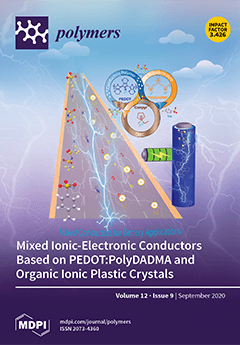Different synthetic strategies were tested for the incorporation of galactose molecules on thermoresponsive nanogels owing to their affinity for receptors expressed in cancer cells. Three families of galactose-functionalized poly(
N-vinylcaprolactam) nanogels were prepared with the aim to control the introduction of galactose-moieties
[...] Read more.
Different synthetic strategies were tested for the incorporation of galactose molecules on thermoresponsive nanogels owing to their affinity for receptors expressed in cancer cells. Three families of galactose-functionalized poly(
N-vinylcaprolactam) nanogels were prepared with the aim to control the introduction of galactose-moieties into the core, the core-shell interface and the shell. First and second of the above mentioned, were prepared via surfactant free emulsion polymerization (SFEP) by a free-radical mechanism and the third one, via SFEP/reversible addition-fragmentation chain transfer (RAFT) polymerization. Synthetic recipes for the SFEP/free radical method included besides
N-vinylcaprolactam (NVCL), a shell forming poly(ethylene glycol) methyl ether methacrylate (PEGMA), while the galactose (GAL) moiety was introduced via 6-O-acryloyl-1,2,:3,4-bis-O-(1-methyl-ethylidene)-α-
D-galactopiranose (6-ABG, protected GAL-monomer): nanogels I, or 2-lactobionamidoethyl methacrylate (LAMA, GAL-monomer): nanogels II. For the SFEP/RAFT methodology poly(2-lactobionamidoethyl methacrylate) as GAL macro-chain transfer agent (PLAMA macro-CTA) was first prepared and on a following stage, the macro-CTA was copolymerized with PEGMA and NVCL, nanogels III. The crosslinker ethylene glycol dimethacrylate (EGDMA) was added in both methodologies for the polymer network construction. Nanogel’s sizes obtained resulted between 90 and 370 nm. With higher content of PLAMA macro-CTA or GAL monomer in nanogels, a higher the phase-transition temperature (T
VPT) was observed with values ranging from 28 to 46 °C. The ρ-parameter, calculated by the ratio of gyration and hydrodynamic radii from static (SLS) and dynamic (DLS) light scattering measurements, and transmission electron microscopy (TEM) micrographs suggest that core-shell nanogels of flexible chains were obtained; in either spherical (nanogels II and III) or hyperbranched (nanogels I) form.
Full article






